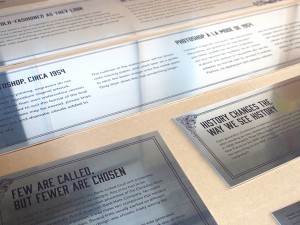Inspecting the Printed Panels
Downtown Sherbrooke with the hills in their autumn glory.
During our last visit to Sherbrooke, the exhibition team checked out the first samples of the proposed printing methods for our upcoming exhibition, Voices from the Engraver. Samples of one or two letters gave us a good idea of the final results, but on this trip, seeing the 8-foot-tall wooden panels with the full copy printed directly onto them was simply fantastic. Using a new process, staff of the exhibition fabrication department at the Sherbrooke Nature and Science Museum have produced impressive results.
The printer lays the ink directly onto the wood surface – no need for printed stickers or acrylic.
In the past, one would print onto a sticky film that would be applied to the panels. Now, however, it is possible to use the panels themselves as the final substrate, retaining the true surface. This process involves a form of ink-jet printer, but nothing like your desk-top HP! The panels are placed flat and the print head moves across them, laying down the ink – no possibility of paper jams, at least (or plywood jams…). A similar process is used for the metal panels, resembling engravers’ plates.
Aluminum cubes will be used to number the artifacts in the drafting table display cases.
This very talented fabrication team really cares about quality and detail. The plywood panels are elegantly grained walnut veneer, but the bases of the drafting-table-style display units are custom built from solid walnut. They will hold not only artifacts but touch-panel monitors for our interactives and our hands-on guilloche (Spirograph®) drawing units.
The design of our ‘make your own bank note or stamp’ photo booth.
Finally taking design shape is our photo booth. Visitors sit for a photograph which is then processed to look like an engraving. To make their own stamp or bank note, they will then be given choices of backgrounds, frames and numbers to choose from plus they can enter a country or bank of their own choice. (Mordor, The Principality of Dave…) A stamp or bank note will be then be sent to their e-mail. Great fun, and we look forward to sharing with you the completed exhibition on our next adventure of exhibit planning.
The Museum Blog
New acquisitions—2024 edition
Money’s metaphors
Treaties, money and art
Rai: big money
By: Graham Iddon
Lessons from the Great Depression
By: Graham Iddon
Welcoming Newfoundland to Canada
By: David Bergeron
New Acquisitions—2023 Edition
Mo’ money, mo’ questions
Understanding cryptocurrencies
By: Graham Iddon
A checkup on cheques
By: David Bergeron
The Scenes of Canada series $100 bill
By: Graham Iddon

















